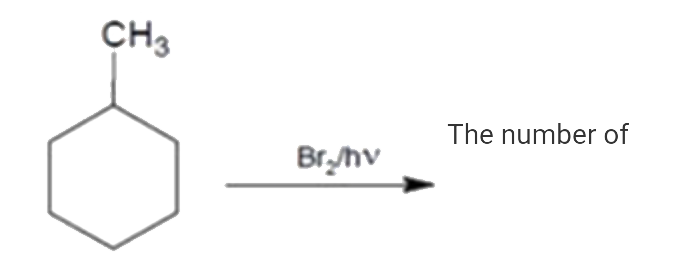An isomer of C6H14 forms three monochloro derivaties. The isomer may be- (Excluding stereo isomer)
neo-pentane
n-hexane
2, 3-dimethylbutane
iso-hexane
The correct Answer is:B
To determine which isomer of C6H14 forms three monochloro derivatives, we need to analyze the possible structural isomers of hexane and their reactivity towards chlorination.
1. Identify the Molecular Formula:
The molecular formula given is C6H14, which indicates that we are dealing with hexane and its isomers.
2. List Possible Isomers:
The possible structural isomers of C6H14 include:
- n-Hexane (straight-chain)
- 2-Methylpentane
- 3-Methylpentane
- 2,2-Dimethylbutane
- 2,3-Dimethylbutane
- 3,3-Dimethylbutane
- Isohexane (2-Methylpentane)
3. Analyze n-Hexane:
- Structure: CH3-CH2-CH2-CH2-CH2-CH3
- When chlorinated, the chlorination can occur at:
- 1st carbon: 1-chlorohexane
- 2nd carbon: 2-chlorohexane
- 3rd carbon: 3-chlorohexane
- The 4th and 5th carbons are equivalent to the 2nd and 3rd, respectively, hence they do not yield new isomers.
- Total unique monochloro derivatives = 3.
4. Analyze 2,3-Dimethylbutane:
- Structure: (CH3)2CH-CH(CH3)-CH3
- All the carbons in this structure are equivalent in terms of their environment, leading to only one unique monochloro derivative.
5. Analyze Isohexane (2-Methylpentane):
- Structure: CH3-CH(CH3)-CH2-CH2-CH3
- The chlorination can occur at:
- 1st carbon: 1-chloro-2-methylpentane
- 2nd carbon: 2-chloro-2-methylpentane
- 3rd carbon: 3-chloro-2-methylpentane
- 4th carbon: 4-chloro-2-methylpentane
- Total unique monochloro derivatives = 5.
6. Conclusion:
After analyzing the isomers, we find that n-hexane is the only isomer that produces exactly three unique monochloro derivatives.
Final Answer:
The isomer of C6H14 that forms three monochloro derivatives is n-Hexane.
The molecular formula given is C6H14, which indicates that we are dealing with hexane and its isomers.
The possible structural isomers of C6H14 include:
- n-Hexane (straight-chain)
- 2-Methylpentane
- 3-Methylpentane
- 2,2-Dimethylbutane
- 2,3-Dimethylbutane
- 3,3-Dimethylbutane
- Isohexane (2-Methylpentane)
- Structure: CH3-CH2-CH2-CH2-CH2-CH3
- When chlorinated, the chlorination can occur at:
- 1st carbon: 1-chlorohexane
- 2nd carbon: 2-chlorohexane
- 3rd carbon: 3-chlorohexane
- The 4th and 5th carbons are equivalent to the 2nd and 3rd, respectively, hence they do not yield new isomers.
- Total unique monochloro derivatives = 3.
- Structure: (CH3)2CH-CH(CH3)-CH3
- All the carbons in this structure are equivalent in terms of their environment, leading to only one unique monochloro derivative.
- Structure: CH3-CH(CH3)-CH2-CH2-CH3
- The chlorination can occur at:
- 1st carbon: 1-chloro-2-methylpentane
- 2nd carbon: 2-chloro-2-methylpentane
- 3rd carbon: 3-chloro-2-methylpentane
- 4th carbon: 4-chloro-2-methylpentane
- Total unique monochloro derivatives = 5.
After analyzing the isomers, we find that n-hexane is the only isomer that produces exactly three unique monochloro derivatives.
The isomer of C6H14 that forms three monochloro derivatives is n-Hexane.
Similar Questions
Chain isomers of C7H16 is :
View SolutionDraw isomers of C4H10
View SolutionThe isomer of C6H14 which will give maximum number of monochloroderivative is
View SolutionHow many isomers of C4H10O reacts with CH3MgBr to evolve CH4 gas ? (Excluding stereoisomer)
View Solution The number of possible mono bromo products are (excluding stereo isomers)
The number of possible mono bromo products are (excluding stereo isomers)
View SolutionNumber of isomers of C5H6
View SolutionOut of all the possible isomers of C5H11Cl, how many are secondary in nature?
(Exclude stereoisomers if any.)
View SolutionHow many coulomb are required for the oxidation of 1 mol of H2O2→O2?
View SolutionHow many isomers of C4H10O reacts with Na metal to evolve H2 gas ? (excluding stereoisomer)
View SolutionNumber of monochloro structural isomers of :

View Solution
